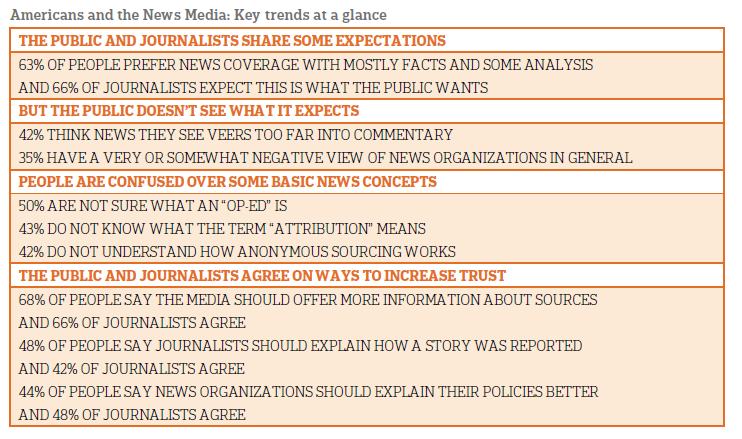
A key factor in the erosion of Americans’ trust of their news media is a failure to communicate — we have a public that doesn’t fully understand how journalists work, and journalism that doesn’t make itself understandable to much of the public.
This fundamental pattern emerges from a new study by the Media Insight Project. We conducted twin surveys of both the public and journalists, asking each group parallel questions about the public’s understanding of journalistic concepts, the public’s interactions with journalists, and how all of that affects people’s assessment of the news media.
The findings released today reveal problems of miscommunication, as well as opportunities. They highlight shared ideals: for example, the public and journalists want the same things from the press — verified facts, supplemented by some background and analysis. But they also reveal dissatisfaction: many Americans think what they see in the news media looks largely like opinion and commentary — not the carefully reported contextualizing they hoped for.
Moreover, the public is confused by some basic concepts of news. Half do not know what an “op ed” is. More than 4 in 10 do not know what the term “attribution” means, and close to 3 in 10 do not know the difference between an “editorial” and a “news story.”
Journalists we surveyed expect some of these results. They think the public has an even lower opinion of journalists, are less able to grasp basic concepts, and are more passive in their news consumption.
Despite the fact that the individual journalists we surveyed say they are aware of, and even overestimate, the level of the public’s misunderstanding of their craft, the broader news industry still has to act on that knowledge — through steps such as transparency, labeling, eliminating jargon, and letting the public participate in the news.
The good news is that progress seems achievable. In addition to shared ideals, the survey finds a substantial desire on the part of both journalists and the public for more transparency.
The public is especially interested in hearing more about sources and individual story decisions. For example, even though a majority of Americans understand what anonymous sourcing is, most also think that even their favorite news organizations should better explain their use of unnamed sources.
People also generally are more frequent, deeper, and more active news consumers than journalists give them credit for. And the public trusts their favorite sources of news and individual reporters more than journalists think they do.
The bottom line: The public is ready for a relationship with more understanding and trust, if news media can take the right steps to earn it.

The two surveys in this study were conducted by the Media Insight Project, an initiative of the American Press Institute and The Associated Press‑NORC Center for Public Affairs Research. The general population survey of 2,019 adults using NORC’s AmeriSpeak® Panel was conducted from March 21 through April 17, 2018, via the web and telephone. The survey of 1,127 journalists was conducted from March 1 through April 12, 2018, via the web.





